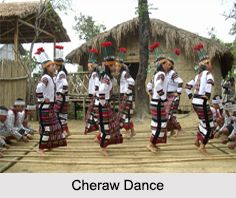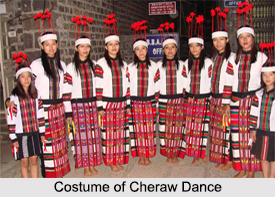 Cheraw Dance is a popular dance performed in Mizoram. It is the most notable dance of Mizoram and a center of attraction during festive season in Mizoram. It is also known as "Bamboo Dance", since bamboos are used in the performance of the dance. Both men and women come together and perform this dance; while the men hold the bamboos, the women dance between the same bamboos. Cheraw Dance is one of the oldest folk dance of Mizoram and also an integral part of almost every Mizo festivals. It is also performed in marriage ceremonies and on the time of merry-makings to celebrate success.
Cheraw Dance is a popular dance performed in Mizoram. It is the most notable dance of Mizoram and a center of attraction during festive season in Mizoram. It is also known as "Bamboo Dance", since bamboos are used in the performance of the dance. Both men and women come together and perform this dance; while the men hold the bamboos, the women dance between the same bamboos. Cheraw Dance is one of the oldest folk dance of Mizoram and also an integral part of almost every Mizo festivals. It is also performed in marriage ceremonies and on the time of merry-makings to celebrate success.
Origin of Cheraw Dance
According to the tales, the Cheraw dance originated as early as in the 1st century AD. In ancient times, Cheraw dance was performed with the hope of providing solace to soul of a deceased mother who had left her newborn child on earth.
Performance of Cheraw Dance
An individual family performs Cheraw dance on the occasion of "Buhza Aih" that is the bumper harvest. Basically, it is not a community dance but a dance performed by a few selected girls having extraordinary skills. At the time of such occasions, large numbers of people gather to watch the proud performance of "Cheraw" dance by the few skilful dancers. It is generally performed on moonlit nights that add a glory to it. At the time of performance, the sound of the bamboo hitting each other is the rhythm for the dance. But even if a rhythm is missed, the experienced dancers perform the steps with a lot of grace and care.
 In the performance, the dancer moves by stepping alternatively in and out from between and across a pair of horizontal bamboos. The men mostly sitting and facing these bamboos on the either side hold these bamboos against the ground and they, tap them by opening and closing them, as per the rhythmic beats. Two bases support the bamboos that are placed horizontally, one at each end. The movements created while clapping them produce a sharp sound, which actually forms the rhythm of the dance. It also indicates the timing for the dancing steps as well. The dancers perform various attractive steps in and out on the beats of the bamboos. Generally, the patterns and stepping of the dance have many variations that are very much graceful. Sometimes the steps are done to imitate some natural movements like the birds or the trees.
In the performance, the dancer moves by stepping alternatively in and out from between and across a pair of horizontal bamboos. The men mostly sitting and facing these bamboos on the either side hold these bamboos against the ground and they, tap them by opening and closing them, as per the rhythmic beats. Two bases support the bamboos that are placed horizontally, one at each end. The movements created while clapping them produce a sharp sound, which actually forms the rhythm of the dance. It also indicates the timing for the dancing steps as well. The dancers perform various attractive steps in and out on the beats of the bamboos. Generally, the patterns and stepping of the dance have many variations that are very much graceful. Sometimes the steps are done to imitate some natural movements like the birds or the trees.
Costume of Cheraw Dance
The female dancers usually dress themselves in traditional dresses like Thihna, Vakiria, Kawrchei and Puanchei. These dresses are designed in such a way that they further brighten up the dance performance.
Musical Instruments for Cheraw Dance
The musical instrument mainly used in this dance form includes two crossed pairs of bamboo staves that the performers hold in their hands. The musical rhythm is created by the clapping of this bamboo staves. In addition, drum and the gong are two traditional musical instruments of the Mizos.



















